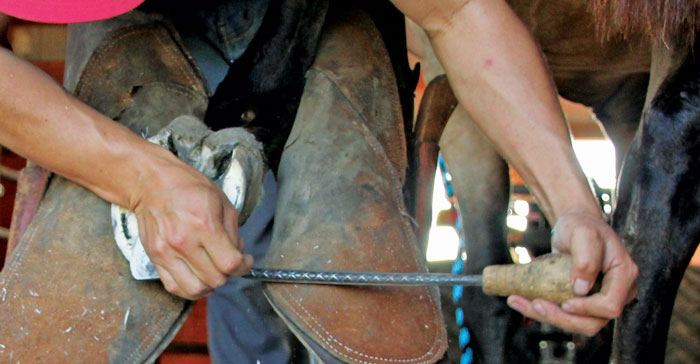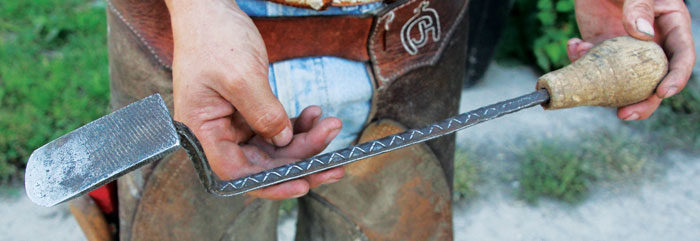A quality hoof knife isn’t a hard-to-find commodity for most farriers. In fact, an impressive number of knives made by a variety of manufacturers are available for purchase in supply shops and from online retailers — making them more accessible than ever.
One tool most farriers won’t see for sale by these retailers, however, is the hoof knife, or “pujavante,” used by Mexican farrier Jesus “Chuy” Jiménez. The 24-year-old lives in Tepetloaxtoc, a city in the state of Morelos, about 2 hours south of Mexico City. A fourth-generation farrier, Jiménez was introduced to horseshoeing at just 13 years old when he was recruited to help his father in the family business. Although an unenthusiastic helper as a teen, over time Jiménez grew to love the work and went on to attend a number of clinics in Mexico and the United States.
For the past 5 years, he has been trimming, nailing, clenching and working hard to progress in his farriery knowledge and skill. Most recently, he traveled to Minnesota where he earned his American Farrier’s Association (AFA) Certified Farrier (CF) designation, and has since passed the horse and shoe exams for the Certified Tradesman Farrier (CTF), but still needs to pass the written.
The hoof knife Jiménez uses is a modified Spanish tool that his blacksmithing great-grandfather fabricated about 80 years ago, but it still serves the family of horseshoers well today. The anatomy is simple, consisting of a handle and blade that are connected by a piece of ¼-inch rebar called a guide. The length of the guide, the angle at which the blade is attached, and the type of handle, are customized to the user, but also consider the farrier’s horse-clients.
Takeaways
- The anatomy of the pujavante consists of a handle and a blade that are connected by a piece of ¼-inch rebar called a guide.
- Many aspects of the pujavante are customized to the user, including the length of the guide and the type of handle; however, the angle at which the blade is attached is determined by the horse. A 90-degree angle is appropriate for most “average” (14-16 hand) horses.
- While there are significant differences in appearance and method of trimming using the pujavante compared with a traditional hoof knife, the effectiveness and safe execution of any trimming tool depends on the skill of the farrier.
Jiménez’s hoof knife has a sphere-shaped wooden handle sized to fit comfortably in the palm of his hand. Depending on the user’s preference, the handle alternatively could be made from plastic, rubber or metal. The guide on Jiménez’s pujavante is about 3 inches long with the blade attached at a 90-degree angle, which is ideal for trimming the Quarter Horses, Friesians and Spanish horses in Jiménez’s practice, as well as most average-sized equines (14-16 hands). For horses that are significantly smaller or larger — a pony or a draft horse, for example — an acute- or obtuse-angled blade, respectively, is necessary. The only part of the pujavante that’s standardized is the size and dimension of the blade, which is 2 inches wide by 3 inches long and ⅜ inches thick at the spine.
When trimming the foot using the pujavante, Jiménez starts from the widest point of the heel, working toward the frog by moving the handle in a clockwise motion and applying gentle pressure to the dull surface of the blade.
Traditional Hoof Knife Vs. Pujavante
Upon seeing him use his pujavante for the first time, a farrier who is accustomed to using a standard hoof knife usually responds with a reaction that’s part wonder, part trepidation, Jiménez says. Farriers who have never used the pujavante are quick to imagine that such a tool in their hands, could cause harm to both farrier and horse. Based on his experience using both a standard hoof knife and the pujavante, Jiménez believes harm could more easily come from the former for a couple of reasons.

Jesus “Chuy” Jiménez, a farrier in Tepetloaxtoc, Mexico, uses his pujavante hoof knife to remove the sole on the hind foot of a Quarter Horse. When trimming the foot using the pujavante, Jiménez starts from the widest point of the heel, working toward the frog by moving the handle in a clockwise motion and applying gentle pressure to the dull surface of the blade. Jesus “Chuy” Jiménez
- The path of the knife. When in use, the sharp edge of the pujavante tracks upward and away from the foot, whereas, the sharp edge of the hoof knife tracks deeper into the foot. The downward movement toward the sole increases the likelihood of unintentional injury to the horse.
- Hand placement. When using the pujavante, one palm directs the pujavante on the handle, while the other palm applies gentle pressure on the smooth, flat plane of the blade. In this hand placement, cutting a thumb or finger would be nearly impossible. Whereas, when holding the handle of the standard hoof knife, the farrier is always pulling the sharp side of the blade in the direction of the knife-wielding arm. Jiménez notes he has seen some farriers use the thumb on the opposite hand to assist in a back-and-forth motion with the hoof knife, which puts the first digit in undue peril.
Despite these points, a farrier’s skill level and a horse’s temperament are significant factors when determining the likelihood of injury by any tool. Injuries may be less likely when properly maintained tools are used by someone who is appropriately trained, while injuries may be more likely when a horse is ill-mannered — regardless of the tool used or the farrier’s level of training.
“I would like to see horseshoers throughout Mexico raise the bar for the industry…”
In terms of tool upkeep, Jiménez finds the pujavante easier to maintain than the traditional hoof knife. It rarely needs to be sharpened, he says, and when it does, it’s easier to sharpen because of its flat shape. Even in the act of sharpening, Jiménez finds it easier to damage the blade of a traditional hoof knife. Other than sharpening, the only other real maintenance required is possibly changing the handle, he says.
Different Tool, Same Goal
Jiménez’s goal when working with any horse is to achieve a trim that best supports the horse in its work and provides sound shoeing mechanics. In general, he prefers to trim horses conservatively, leaving the amount of foot one would expect to find a week after the farrier’s visit and minimal pressure on the sole.
Jiménez understands why his industry colleagues are fascinated by the pujavante, but even if they use different tools, they all have the same goal — to trim the horse to the best of their knowledge and ability. While there are many farriers in Mexico, Jiménez notes it wasn’t until recently that more educational opportunities such as clinics sponsored by farrier industry businesses and outreach from the AFA have made it possible to standardize the quality of footcare in the region he works.
“I would like to see,” Jiménez says, “horseshoers throughout Mexico raise the bar for the industry.”









Post a comment
Report Abusive Comment